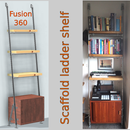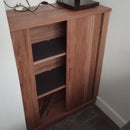Introduction: Scrap Wooden Hinged Box
I used to make a boxes every now and again but hadn't made one for a while so now I thought I'd make a nice small box from scrap wood. I have recently made a bread bin and a headphone stand from scrap wood and had the idea of using thin bits of wood to form the hinge.
I have made other boxes with wooden hinges but they were all solid bits of wood with finger joints and I thought lots of tiny 'finger joints' would look really good.
Supplies
Materials
Scrap wood - I used oak, sapele, yew and ash
6mm bolt for the hinge mechanism
Tools
Bandsaw
Mitre saw
Drills
Sanders
Step 1: Prepare the Wood
I started of by cutting the wood to the same thickness and width with a band saw. I then used an ogee bit to make a radius on one side of one end of each piece, this would enable the hinge to move!
I then marked a centreline on each of the pieces, on each long edge, and the the same distance from the end to give me the centre of the hinge pivot. I then used a pillar drill to create the hole in this point. I drilled from both sides a bit more than half way in so I knew they would meet up. At least it shower me that me drill was quite well set up.
I then made sure it was large enough for a piece of threaded rod I had. In the end I just used part of a bolt for the hinge instead of the rod (but they were the same diameter)
Step 2: Turn in to Strips
I then sliced thin strips (approx. 2.5mm) on the band saw using a scrap piece of wood to push the strips past the blade. I made 8 from each type of wood.
I then made some similar sized pieces without a hole or radius for the rest of the body. I made 12 of these for each type of wood.
Step 3: Glue Hinge
I started off by arranging the wood pieces on the bolt and glued each individual piece one by one, one side at a time. I then clamped each side and removed the bolt so I could add other clamps easily. This would ensure that the hole would stay aligned.
Once dried I made sure they went back together and opened at right angles. They didn't quite go to 90 degrees so I sanded a little more to the radius until they did.
Step 4: Add the Bottom
For the bottom I glued all the bits to each other and the back panel 'pins'. This was quite a messy process and there was a lot of squeeze out glue so took a bit longer to clean up that I would have liked!
Step 5: Front Panels
For the front panels I made the sections individually and once glued I could easily sand it and only use minimal glue when attaching to the top and bottom. Only a small amount of glue was needed though as everything was quite tight anyway.
Step 6: Side Panels
I then found a bit of yew that I haven't used before as it looked fairly unusable. As I only need thin sides I cut a couple of 5mm slices and the yew turned out to be just big enough.
I started by roughly cutting them to size and then cut them on an angle to make the lid a little more interesting. I then glued the bottom sides to the box and sanded them flush once it had been clamped and dried.
Finally I fitted the lid to the body and inserted a bolt that I had chopped down to size. I then glued and clamped the top side panels which would hide the bolt ends.
I then sanded the side panels flush
Step 7: Finishing
I wanted a nice, smooth and shiny finish so I sanded the outside up to 400 grit and applied a clear coat spray finish. This was left over from spraying a wing mirror of my van after it got smashed off by another van :(
I applied four thin coats of the clear coat and finished off by buffing with a pad on my sander.
I was actually quite surprised that it turned out so well and all the thin bits lined up!!!
I most likely add some kind of a padded insert in to it for some cuff links but not 100% sure yet.
If you found this interesting please vote for it in the scraps contest. Thanks!!

Grand Prize in the
Scraps Speed Challenge











